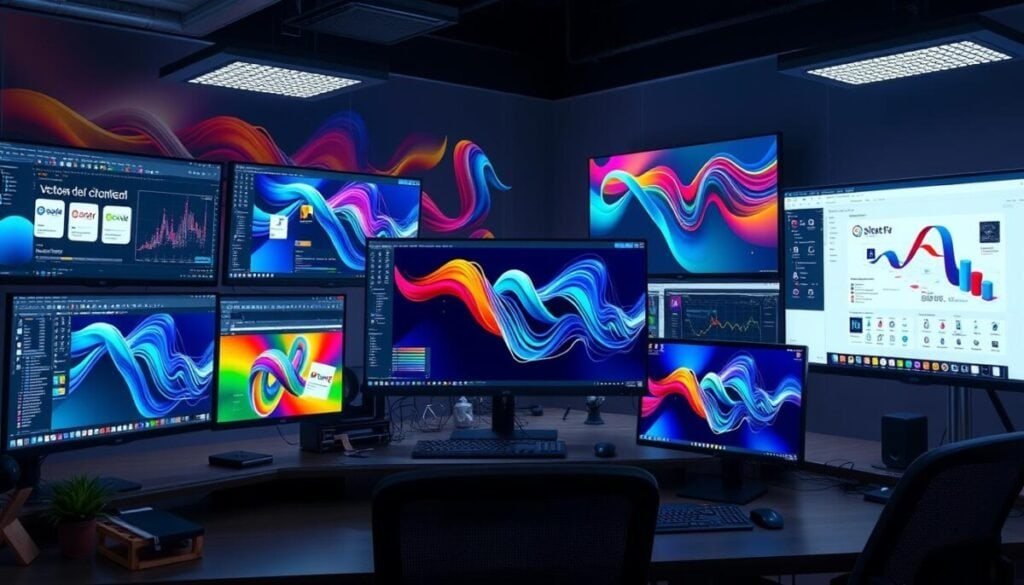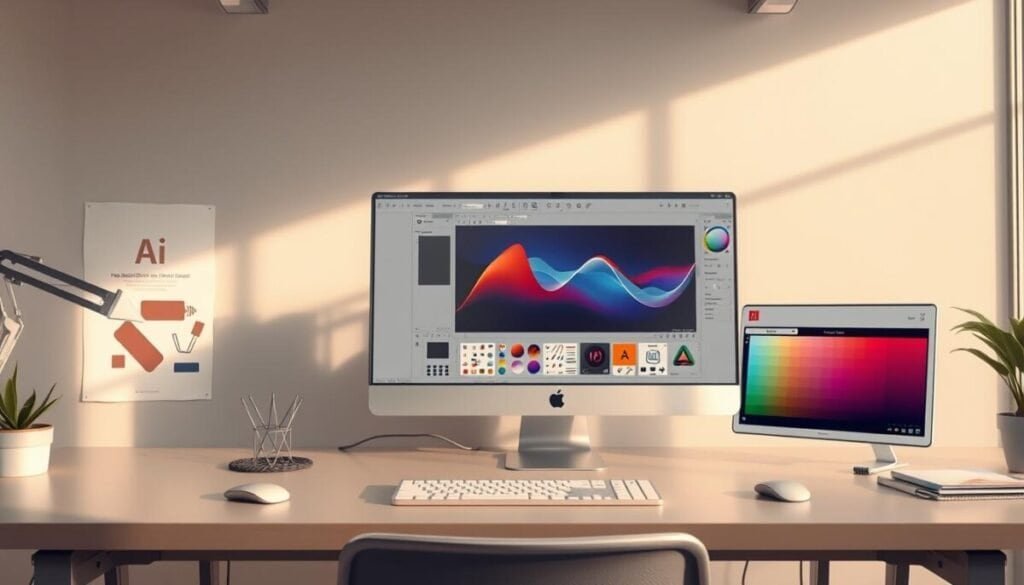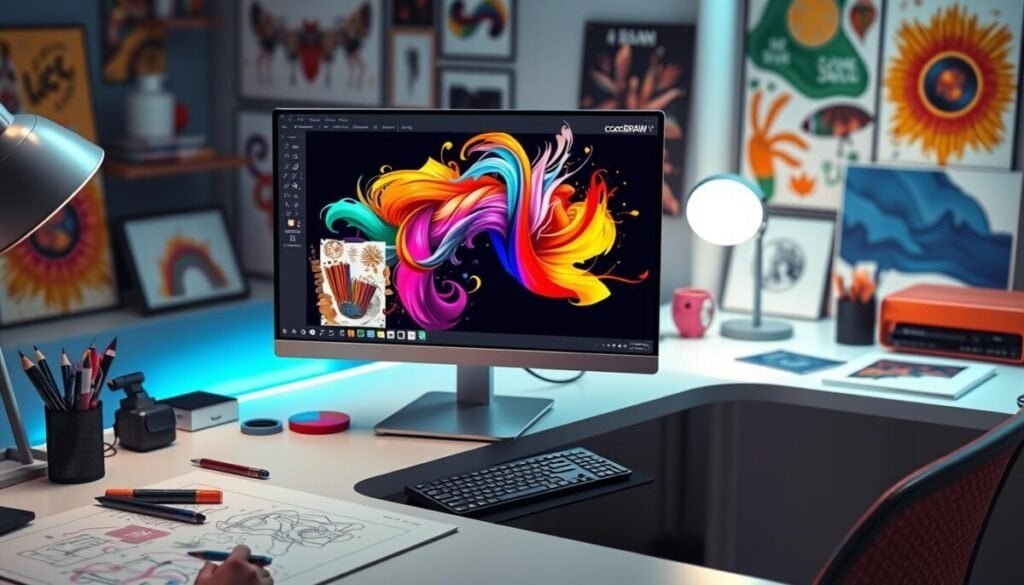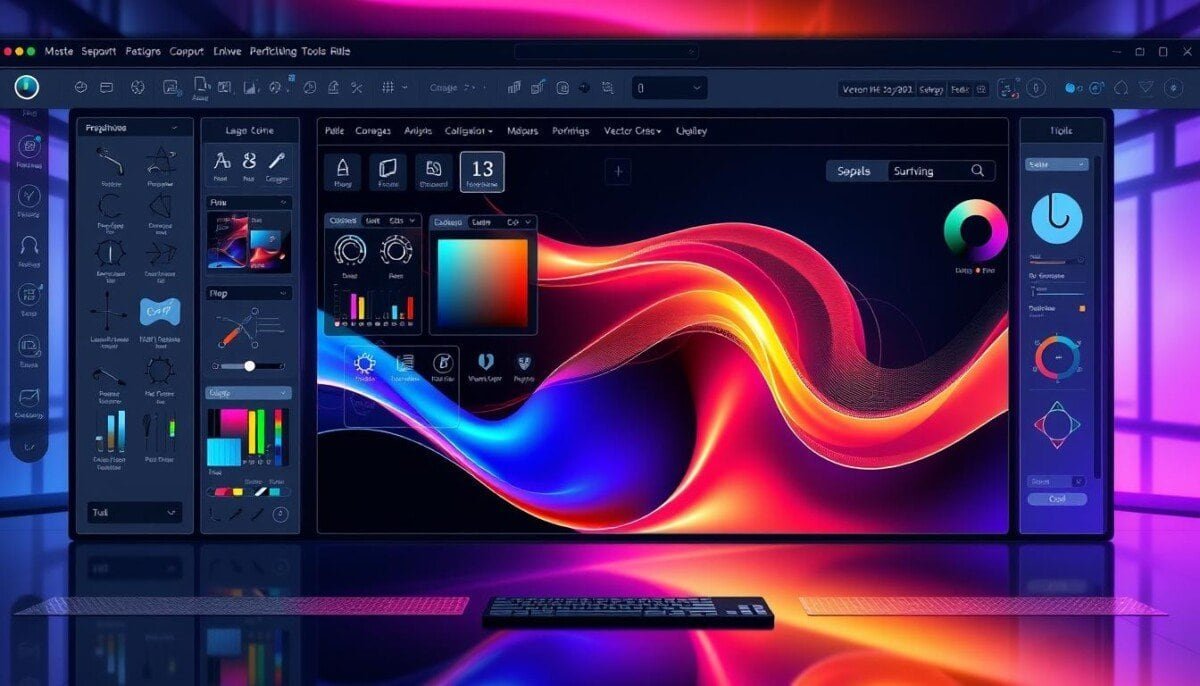We’ve all seen it – a pixelated logo on a billboard makes us cringe. The blurry edges of an image when it’s scaled up are even worse. This is why vector graphics software is so magical.
It’s not just changing how we create. It’s changing what we can create. Remember the first time you zoomed into a vector image and saw its crisp lines? That’s the power of vector graphics software.
It’s a game-changer for designers. It lets them create without losing quality. From making intricate logos to designing big billboards, these tools are amazing.
Vector graphics software has come a long way since Ivan Sutherland’s Sketchpad in 1963. Today, it’s a must-have for creators in all fields. It lets both pros and new artists bring their ideas to life.
From sleek web graphics to eye-catching flyers, it keeps quality high at any size. It’s a world of possibilities.
Key Takeaways
- Vector graphics maintain quality at any size
- Essential for logo design and scalable graphics
- Versatile for web, print, and digital media
- Offers precision and flexibility in design
- Supports various file formats for compatibility
- Enables seamless collaboration in design teams
Understanding Vector Graphics Software
Vector graphics software has changed how we make digital art. It started in the 1960s with early computer displays. Now, it’s a key tool in design, using math to make images that grow without losing quality.
What is Vector Graphics Software?
Vector graphics software is a digital tool for drawing. It uses math to make images that stay sharp no matter the size. This is why it’s great for logos, illustrations, and detailed drawings.
Advantages of Vector Graphics
Vector graphics have many benefits over raster images:
- Infinite scalability without losing quality
- Smaller file sizes
- Easy to edit
- Precision in design
- Works well on any device
Key Features of Vector Graphics Programs
A good vector graphics program has several key features:
| Feature | Description |
|---|---|
| Drawing Tools | Pen tool, shape tools, and brushes for creating paths and shapes |
| Shape Manipulation | Tools for combining, splitting, and modifying shapes |
| Color Management | Advanced color tools for creating and applying color schemes |
| Export Options | Ability to save in various vector formats like .ai, .svg, and .eps |
Knowing these features is key to mastering vector art tools. With practice, designers can make amazing visuals that look great everywhere.
Popular Vector Graphics Software Options

The world of graphic design applications is vast. It offers many vector graphics software options. Designers can choose from top brands and open-source tools, fitting their needs and budgets.
Adobe Illustrator, launched in 1985, is the top choice. It’s part of the Creative Cloud suite, offering many tools for pros. But, its subscription model can be pricey for some. For those looking for cost-effective options, there are plenty of alternatives to Adobe Illustrator that still deliver powerful features. Additionally, creatives exploring specific design needs might also consider alternatives to ideogram.ai for imaging, as the market offers a variety of tools catering to different preferences and budgets. Whether for vector graphics or AI-powered imaging, the right choice often comes down to balancing functionality with affordability.
CorelDRAW, released in 1989, is a strong alternative. It has flexible licensing, including subscriptions and one-time buys. It works on many operating systems, reaching more users.
Inkscape is a free, open-source vector editor. It’s great for many design tasks, even though it lacks some advanced features of paid software.
Affinity Designer is a new player that’s catching up with Adobe Illustrator. It’s available for a one-time purchase, appealing to those who don’t want subscriptions.
| Software | Pricing Model | Free Trial | Key Feature |
|---|---|---|---|
| Adobe Illustrator | Subscription ($22.99/month) | 7 days | Industry standard |
| CorelDRAW | Subscription or one-time purchase | 15 days | Flexible licensing |
| Inkscape | Free | N/A | Open-source |
| Affinity Designer | One-time purchase ($69.99) | 30 days | Non-subscription alternative |
Adobe Illustrator: Industry Standard for Vector Design

Adobe Illustrator is the top choice for vector graphics. It has been a key tool for designers since 1987. Today, it has 30 million users on Adobe Creative Cloud, showing its big impact.
Key Features of Adobe Illustrator
Adobe Illustrator has many powerful features. These make it stand out from other vector graphics programs:
- Precise path creation with the Pen Tool
- Shape manipulation using the Shape Builder Tool
- Advanced color management and gradient options
- Seamless integration with other Adobe Creative Cloud apps
- Support for multiple file formats (AI, SVG, PDF, EPS)
Pros and Cons of Adobe Illustrator
| Pros | Cons |
|---|---|
| Industry-standard software | Steep learning curve |
| Regular updates and new features | Subscription-based pricing ($22.99/month) |
| Extensive plugin ecosystem | Resource-intensive on older hardware |
| Robust community support | Overwhelming for beginners |
Ideal Users for Adobe Illustrator
Adobe Illustrator is for many professionals in the creative field:
- Graphic designers working on branding and logos
- Illustrators creating detailed vector artwork
- Web designers developing scalable graphics
- Print media professionals preparing high-quality visuals
- UI/UX designers crafting user interface elements
Adobe Illustrator’s price might be a barrier for some. But its unmatched features and wide acceptance make it a great choice for serious designers.
CorelDRAW: Versatile Vector Graphics Suite

CorelDRAW is a top choice in vector design software. It has a user-friendly interface and powerful tools. This makes it great for both newbies and experts.
CorelDRAW offers flexible licensing options. You can pick between subscription plans or one-time buys. This suits different budgets and needs.
CorelDRAW is a hit in many fields. Sign makers and fashion designers love it for its tools. But it’s also popular in engineering, manufacturing, and construction for detailed illustrations.
Here are some examples of how CorelDRAW is used:
- Yellotools, a German company, uses CorelDRAW for innovative sign-making solutions
- Swedish artist Stefan Lindblad relies on Corel PHOTO-PAINT for illustrations
- Bitsy & Company from the USA creates graphic novels using CorelDRAW for character design and layout
- TMS Print Systems in the USA handles large companies’ signage needs with CorelDRAW Graphics Suite
Users really like CorelDRAW. It has ratings of 4.3 and 4.5 out of 5. People love its vector illustrations, pixel brushes, and special tools like Focus Mode.
| Feature | User Rating |
|---|---|
| Vector Illustrations | High |
| Pixel-Based Brushes | High |
| Focus Mode | High |
| Sticker Creation | High |
| Icon Design | High |
While Adobe Illustrator is a big name, CorelDRAW is a strong rival. It supports many file formats and is easy to learn. This makes it a great choice in the vector design world.
Open-Source Alternatives: Inkscape and SVG-Edit
We’ve looked at many vector graphics software options. But, let’s not forget the power of open source vector editors. These tools are affordable and still pack a punch.
Inkscape: Powerful Free Vector Editor
Inkscape is a top-notch open-source vector editor. It works on GNU/Linux, Windows, and macOS. Many designers choose it for its ability to create detailed illustrations, logos, and cartoons.
It has a wide range of vector shapes and tools. This makes it great for both newbies and experts.
SVG-Edit: Browser-Based Vector Editing
SVG-Edit is perfect for those who want a quick, easy solution. It’s great for simple edits and works well in a team setting. It might not have all the bells and whistles, but it’s easy to use.
Comparing Open-Source to Commercial Options
When deciding between Inkscape and commercial software like Adobe Illustrator or CorelDRAW, think about what you need. Open-source tools like Inkscape offer basic features for free. But, they might not have all the advanced tools or support.
Commercial software, on the other hand, costs more but has more features and support. Your choice depends on your project’s needs and your budget.

